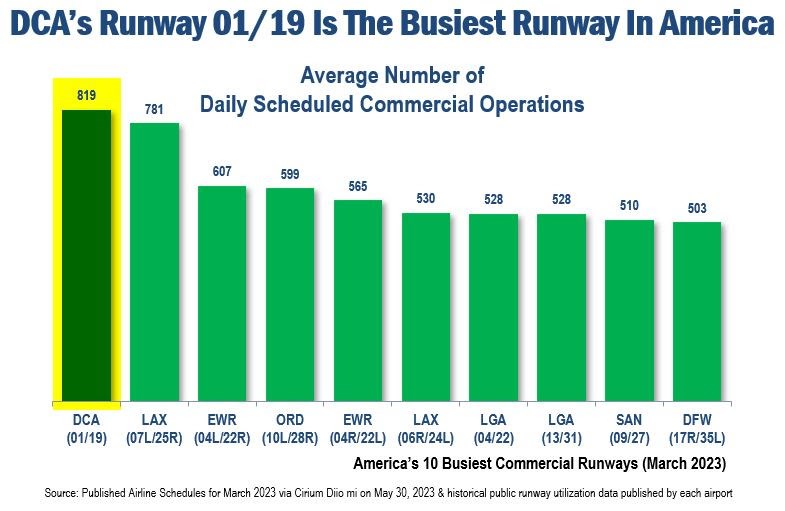Ronald Reagan Washington National Airport is home to the busiest airport runway in the nation, according to the Metropolitan Washington Airports Authority, which is promoting the data to defeat efforts at bringing more flights there.
Reagan National’s main runway – dubbed Runway 01/19 – each day handles an average of 819 scheduled commercial operations. The only other runway that comes close is Runway 07L/025R at Los Angeles International Airport, with an average of 781 operations.
“DCA operates at full capacity, with a takeoff or landing every minute, for much of the day,” said Airports Authority president/CEO Jack Potter. “Adding more flights to this already-packed schedule would lead to more delays, which would result from the need to accommodate the spacing between aircraft operations that is required to assure safety.”
Some in Congress are hoping to win support for legislation that would both add more take-off and landing slots at the airport, and ease limits on non-stop service beyond the airport’s 1,250-mile perimeter. Local governments, business organizations and elected officials have joined with the airports authority in opposing the efforts.
After those at Reagan National and Los Angeles International, the most-utilized runways in the nation are found at Newark-Liberty International (an average of 607 flights per day on 04L/22R and 567 per day at 04R/22L) and Chicago-O’Hare (599 a day on average on 10L/28R).
(The numerical naming denotes a runway’s position on the compass with the third digit eliminated, leading to numbering from 1 to 36. While the 7,200-foot-long Runway 01/19 is the primary runway used by commercial aircraft at Reagan National, there are two additional runways that intersect it and are available for use.)
Potter said the runway statistics, based on published airline schedules and data from the Federal Aviation Administration, dispel claims by proponents of additional flights that the airport is underutilized.
“How can anyone credibly say that Washington’s smallest airport, with the busiest runway in America, is underutilized?” he asked. “Anyone who uses Reagan National sees the steady stream of aircraft throughout the day and has experienced the long lines of planes waiting to take off or arriving flights waiting for gate space, especially in bad weather.”
Potter added that DCA – despite being the smallest of Washington’s three major airport in terms of runway capacity, terminal space and other infrastructure – already serves 24 million passengers each year, currently the highest number in the region.
“In addition to exacerbating delays and inconveniencing customers, more flights at Reagan National would bring more crowding, more congestion and more stress on airport facilities,” he said. “While DCA is very popular because of its proximity to Capitol Hill, it simply cannot accommodate all the flights that airlines want to send to Washington.”
While National Airport was effectively the creation of President Franklin Roosevelt – who cobbled together the funding and picked the location – Congress has long considered oversight of the facility its exclusive domain, even after day-to-day operations were turned over to a regional body (the Metropolitan Washington Airports Authority) in the 1980s.
Restricting non-stop service to half the country was put in place decades ago to assist the growth of Washington Dulles International Airport the iron-clad restriction has been eased over time. Currently, there are 20 round-trip pairs allocated for destinations beyond the 1,250-mile perimeter.



